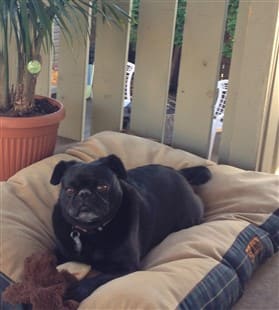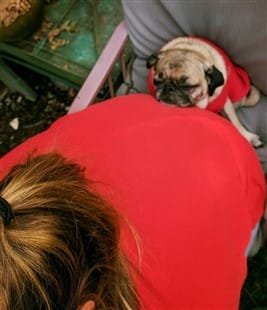Allergies

Pug Dog Allergies
Overview
Just about 20% of dogs suffer from some sort of allergy, and symptoms can vary quite a bit. This ranges from respiratory troubles to skin issues with intense itching, and in some cases, intestinal distress.
Signs may also come and go or flare up during just certain times of the year. Other Pugs may have year-round problems.
Many owners have trouble pinpointing the exact causes and completely treating their Pug puppy or dog. Fortunately, with some work, a Pug's allergies can be successfully remedied.
To help your Pug be on the road to feeling better, this section will cover:
- Common symptoms
- Diagnosing options
- What a Pug can be allergic to
- How to control each type
- Top remedies and cures to treat skin and other issues seen with allergies
- Tips to keep allergies away for good
To help your Pug be on the road to feeling better, this section will cover:
- Common symptoms
- Diagnosing options
- What a Pug can be allergic to
- How to control each type
- Top remedies and cures to treat skin and other issues seen with allergies
- Tips to keep allergies away for good
Common Symptoms with Pug Dog Allergies

Cash, at 12 years old,
photo courtesy of Carol
Though one, some, or all of these may apply to your Pug, this is a brachycephalic breed that is prone to skin issues; for this reason, many Pugs will have at least one respiratory symptom and/or at least one skin-related problem.
Possible allergic reactions seen with Pugs include:
- Respiratory issues - Coughing, wheezing, sneezing, increased snoring, trouble breathing, and/or congestion
- Nasal discharge
- Eye discharge and/or bloodshot eyes
- Increase in ear infections
- Skin issues - Itching, rash, irritated skin, skin sores, hot spots, and/or thinning fur. Note that itching may be all over, or may be only apparent on certain areas like the paws.
- Behavior in response to itching - Licking or chewing at the paws or other itchy areas, rubbing the body against surfaces, and/or scratching at the ears.
- Stomach distress - Nausea, diarrhea, vomiting, and/or general upset stomach
How to Diagnose Pug Dog Allergies
How to Diagnose Pug Dog Allergies

Poppy, at 4 months old,
photo courtesy of Maria
Finding out exactly what a Pug is allergic to is easier said than done; however, there are reasons for both seeing the veterinarian and for handling allergies with home remedies.
Let's see the choices in regard to diagnosing:
Vet tests
- Veterinarians can run certain tests; but, these have pros and cons. There is blood testing (usually ELISA testing) that check the blood for anti-allergens and there is also intradermal skin testing. Both are only 70 to 75% accurate. There can be false positives and misinterpreted results.
With both tests, dogs cannot be given any antihistamines for at least a month prior, which can be a problem. And, with skin testing, dogs need to be sedated, which is not always an ideal choice.
However, reasons for seeing the vet include ruling out other conditions that can mimic allergies such as mites or yeast infection. And, the vet can prescribe allergy medications if symptoms are severe.
Diagnosing at home- While the veterinarian can certainly be helpful with diagnosing, it is with the process of elimination that many owners are able to help cure their dog's allergies.
In fact, you do not need to actually pinpoint the exact
allergen to successfully treat your Pug. If you work to reduce or eliminate all of the most common triggers, along with treating your Pug for itchy skin and other reactions, this may be enough to bring about both effective and lasting relief.
While each dog reacts differently when having allergies, here are some tips that can help narrow things down a bit:
• In general, pollen-type seasonal allergies will be worse during certain seasons; note that winter is not off-limits with this, since certain trees in some warmer climates release pollen in the wintertime.
• Contact allergies often present as rash along the mouth and/or body.
• Food or airborne allergies often present as itchiness, with or without other symptoms.
• Stomach issues are usually related to food allergies; but a dog can have food allergies without this symptom.
What a Pug can Be Allergic To
If your Pug has allergies, the trigger will be within one of these 3 categories:
Food
- This refers to anything within a Pug's diet, in meals
and/or snacks. Often, the allergen will be a dog food additive. At the top of this list are synthetic preservatives, food coloring dyes, and/or artificial flavoring such as MSG.
This also includes fillers such as corn, soy, wheat, and/or a high grain content. While it is a possible allergen, rice is much more tolerated than other grains due to both germ and bran being removed.
And, in rare cases, a dog can be allergic to a certain protein or eggs. Milk is often listed as an allergen; however, canines have a dairy intolerance, which is different; their bodies have trouble digesting milk products.
(continued below)

Chaka, at 7 years old,
photo courtesy of Michelle
Airborne
- Allergens in this group are also referred to as inhaled, or seasonal (despite the fact that they can occur all year round).
This includes pollen, weeds, and grasses. It also includes dust (dust mites and their droppings are often the true trigger) or mold. Fine particles in the air such as air freshener sprays are also possible.
Contact
- This includes anything that a dog comes into physical contact with. One of the most common triggers are plastic bowls. Certain toys and fabrics may be the source as well.
Actions to Take for Each Type of Allergen
If your Pug is suffering from allergies, the goal should be to limit as many allergens as possible. In doing so, this creates an overall healthier environment; so, even if you remove a few that are not causing problems, it will still be beneficial for your puppy or dog.
In addition, treating the symptoms (upset stomach, itching, rash, etc.) is a huge part of this. Many dogs struggle to heal up after allergens are removed since it can take the body a long time to recover from reactions. For example, with food allergies, symptoms may not resolve until up to 3 months after the offending culprits are removed from the diet.
In addition, treating the symptoms (upset stomach, itching, rash, etc.) is a huge part of this. Many dogs struggle to heal up after allergens are removed since it can take the body a long time to recover from reactions. For example, with food allergies, symptoms may not resolve until up to 3 months after the offending culprits are removed from the diet.
Resolving Food Allergies with a Pug
1. If your Pug has gastrointestinal issues, with vomiting and/or diarrhea, this often warrants withholding food for 24 hours to allow the body to rest. Be sure to offer lots of water. This is followed by 3 days of a bland diet consisting of one protein (white breast chicken meat is often well tolerated, but this can also be lean beef) and one carb (sweet potato or white rice are good choices).
2. Switch to a 100% wholesome food or to home cooking. If your Pug does not have stomach issues, but has itching or skin problems, this should be done immediately. If your Pug had stomach issues, this should be done after the 3 days on the bland diet.
With both of these choices, the end result will be the same: A diet with zero additives, preservatives, coloring, artificial flavoring, soy, corn, or wheat. An excellent kibble brand is Wellness CORE Dry Grain-Free for Small Breeds ; this meets all of the requirements of what you're looking for.
; this meets all of the requirements of what you're looking for.
3. Don't forget about snacks.
If the main food is free of the top irritants, but the snacks are not, there can still be allergy issues. Look for 100% all-natural, no preservative snacks. Wellness Soft WellBites Grain-Free Treats
 is a great choice that meets all of the requirements.
is a great choice that meets all of the requirements.
And for a Pug that is on a lower-calorie diet, Zuke's Skinny Bakes Dog Treats
 are excellent.
are excellent.
4. Treat skin symptoms. If your Pug has itching, rashes, or other skin issues, certain sprays or lotions, and shampoo can help. Details on this are in the next section of Treating a Pug's Allergy Skin Reactions.
(continued below)

Cozmo, at 1 and 1/2 years old,
photo courtesy of Kerry
Resolving Contact Allergies with a Pug
1. Remove possible culprits.
This includes things that a Pug regularly mouths such as certain toys (cheaply made, brightly colored toys are suspect).
This also includes food and water bowls if they are made of plastic; those made of stainless-steel or ceramic are best. As always, Pugs should have floor-level bowls to help prevent bloat, and if the dog is a fast eater, a slow-feeding bowl like the DuraPet Slow-Feed Premium Stainless Steel Bowl
 is best.
is best.
Look to flooring that a Pug rests or sleep on. Certain carpet materials can be the trigger.
If a Pug comes into contact with clothing or bed linens, laundry detergent may be to blame; wash everything with hypo-allergenic laundry soap.
Finally, assess grass and lawn areas that your Pug may be walking over; weed control products, pesticides, and/or fertilizer may be causing problems.
2. Treat skin symptoms.
If your Pug has skin issues including rash, itching, sores, hot spots, etc. topical lotions or sprays, and a good specialty shampoo can help quite a bit. Details are ahead in the Treating a Pug's Allergy Skin Reactions
section.
Resolving Airborne Allergies with a Pug
With this, you will be dealing with particles too tiny to see, and while that may seem awfully tricky, fortunately, there are some measures that can work to significantly reduce a dog's exposure:
1) Remove allergens from the house
1.
Vacuum the entire house (no matter the type of flooring) and all fabric furniture on a regular basis with a vacuum cleaner that has a sealed HEPA filter. This will trap 99.97% of all particles with a diameter of 0.3 microns or more, which includes pollen, dust, and mold spores.
A recommended vacuum is the VonHaus 2 in 1 Vacuum Cleaner with HEPA Filtration .
.
2.
Clean the air. If you have a central air system, run the fan while using HEPA filters. Note that when trying to clear the air of allergens, these types of filters should be changed once per month.
If you do not have central air, a portable, standalone air purifier can work well. Do note that you may need more than one; each will be sized to handle a certain amount of square footage.
For example, the GermGuardian 3-in-1 Air Cleaning System with True HEPA Filter
 is a small but powerful device that effectively cleans the air of a 200 sq. foot room, and even kills bacteria and germs.
is a small but powerful device that effectively cleans the air of a 200 sq. foot room, and even kills bacteria and germs.
3.
Wet dust the house at least once a week. Dry dusting only moves around particles; use a dusting spray like Pledge Dust and Allergen Spray . This will remove 90% of allergens found in dust. And, this can be used on a variety of household surfaces including wood, laminate, stainless steel, leather, marble, granite, and plastic.
. This will remove 90% of allergens found in dust. And, this can be used on a variety of household surfaces including wood, laminate, stainless steel, leather, marble, granite, and plastic.
4.
Throw away any old pillows and toss out any mattresses not in use. This is to remove dust mites. These do live in dust (up to 1,000 for each 1/2 teaspoon of dust); However, despite the name, dust mites also live in mattress, pillows, carpeting, and other materials where they can burrow down deep. Their droppings are what can cause terrible allergies.
Shockingly, if a pillow was not properly protected, after 2 years, one-third of its weight will be comprised of dust mites and their droppings. A mattress can contain tens of thousands of mites; they live there and feed off of your dead skin cells.
5.
Cover pillows and mattress with mite-proof coverings. If you cannot afford to toss out your bedding, you can trap existing mites inside. And, if you are going to get new bedding, this sort of protection will prevent mites from entering into the fibers.
Pillow covers like the AllerEase Cotton Allergy Protection Pillow Protector
 have a tight weave that mites cannot penetrate.
have a tight weave that mites cannot penetrate.
(continued below)

Luca and Marco, both 2 years old,
photo courtesy of Phil Cabibi and Tom Estok
6.
Wash as many household objects as you can (toss pillows, throw rugs, soft stuffed animal toys, etc.) in hot water that is at least 140 F. This is the temperature needed to kill mites.
7.
Don't allow allergens to be tracked into the house on your shoes. Remove footwear each time you enter the house and keep these up high and out of the way.
2) Keep allergens off your Pug
1.
Each time that your Pug comes back inside the house, wipe the coat down with a grooming wipe. We recommend Earthbath All Natural Hypo-Allergenic Grooming Wipes .
.
2.
Apply a quality paw wax each week. This will help repel some of the irritants encountered when outside. We recommend Musher's Secret Paw Wax ; this offers a great layer of breathable protection and can even help heal raw or damaged paw skin.
; this offers a great layer of breathable protection and can even help heal raw or damaged paw skin.
3.
Even with paw wax, you'll still want to rinse off the paws after your Pug comes inside so that allergens are not tracked into the house. You may find that using the kitchen sink is fast and effective.
4.
Stay aware of allergen levels in the air. Most local weather reports show this alongside the forecast.
On days that are ranked 'high', avoid midday walks; early morning and evening walks are best.
On days that are ranked 'high', avoid midday walks; early morning and evening walks are best.
3) Treat skin symptoms
As with all types of allergies, if your Pug is itching like mad, is biting at his paws, has a rash, hot spots, or any other troublesome signs, using a spray or lotion and an allergy shampoo can bring about relief. We will cover this aspect next.
Treating a Pug's Allergy Skin Reactions
If your Pug has allergies, most likely your puppy or dog has a lot of itching. There may also be a rash, inflamed skin, hot spots, thinning fur, and/or excessive licking or biting at the paws. Fortunately, there are remedies for these issues. Please keep in mind that these can help quite a bit, but you will also want to be working on reducing allergens as covered earlier. Removing triggers and
treating symptoms is a surefire way to help a Pug feel better fast.
Let's see what can help.
Sprays
A topical spray is a very good option
if your Pug would rather not have sensitive areas touched,
and has specific spots on the body that are bothersome.
There are 2 types; medicated and non-medicated:
Medicated is a good choice if the areas are not easily licked, and/or if your Pug has super-intense itching and/or severe discomfort. If you feel that your Pug's symptoms are severe enough to warrant a medicated spray, but it is an area that can be licked or nibbled at, you may want to place a protection collar on your puppy or dog.
The other option is an organic spray, and these can be very effective as well. This is a good choice if it is the paws that are are itchy and you do not want to use a protection collar and/or if your Pug is uncomfortable, but not so much that you feel topical medications are needed.
Recommended medicated spray:
A very effective anti-itch spray is SynergyLabs Clinical Care Medicated Spray . This has both lidocaine (a great numbing agent) and hydrocortisone (which works great for both itching and inflammation). Use this up to 4 times per day and have the last application be at night right before your Pug goes to sleep.
. This has both lidocaine (a great numbing agent) and hydrocortisone (which works great for both itching and inflammation). Use this up to 4 times per day and have the last application be at night right before your Pug goes to sleep.
Recommended organic sprays:
For itching, rash, and/or inflamed skin, all-natural non-toxic ingredients like colloidal oatmeal, baking soda, and wheat germ can offer fast relief. We recommend Bodhi Dog's Anti-Itch Spray
 .
.
For hot spots, which are areas of moist raw skin, often with thinning fur, you'll want a spray that has healing ingredients. This includes soothing aloe vera and/or tea tree oil. We recommend Vet's Best Hot Spot Spray .
.
Lotions
A lotion is a great option if a Pug's
itchiness, rash, or other allergy-related issues
are nearly all over the body.
A lotion will allow you to cover large areas on the body and is a great method to provide super-soothing relief for a variety of issues.
One lotion that works incredibly well for severe itching, hot spots, inflamed skin, dry skin, rash, and can even prompt fur growth in thinning or balding spots, and also works to fix other issues (and a reason to keep this on hand) like cuts, burns, cracked paws, mange, and insect bites is ResQ Organics Pet Skin Treatment Lotion .
.
This is packed with soothing and restorative, organic ingredients including aloe vera, Manuka honey, coconut, olive oil, hemp seed oil, shea butter, cehami (and Australian botanical known to stop itching and regenerate skin cells), and vitamins A, B, E, and E.
Allergy Shampoos
On its own or alongside a spray or lotion,
an allergy shampoo is an opportunity to
saturate your Pug's entire body with soothing relief.
When your Pug is suffering from allergies and you have a quality shampoo to help with that, you can give your Pug a bath much more often than the typical every-3-weeks. Most dogs do good with a soak in allergy shampoo 1 to 2 times per week.
An excellent and effective organic allergy shampoo is Moosh All-Natural Anti-Itch Allergy Shampoo for Dogs . This is packed with just about everything you'd want; it has Bentonite clay, neem oil, argan oil, shea butter, aloe vera, nutmeg, coconut, olive oil, sunflower oil, and rosemary.
. This is packed with just about everything you'd want; it has Bentonite clay, neem oil, argan oil, shea butter, aloe vera, nutmeg, coconut, olive oil, sunflower oil, and rosemary.
Tips:
No matter which allergy shampoo you use, do be sure that it is non-irritating; some specialty shampoos (like those to eradicate mites or ringworm) can be very harsh if used a lot and particularly if a dog does not have that sort of issue. Using that type of product can make things much worse.
Be sure to use lukewarm water; hot water will irritate skin. You can test the water temperature using your inner wrist.
Once you lather your Pug up, allow the product to soak in for 10 minutes before rinsing out.
When you take your Pug out of the bath to dry him, be sure to gently pat the coat; do not rub.
Omega Supplements
While this cannot cure most allergy-related skin issues on its own,
this can be a good option to use in conjunction
with other treatments
to improve skin and coat health.
You may want to consider using this alongside other remedies or to offer this once your Pug has recovered from allergies in order to keep the skin healthy (and able to better withstand issues in the future).
There are 11 different types of omega and 3 types of omega-3. With omega-3, there is ALA which comes from plants, and EPA and DHA which comes from fish.
It is the EPA and DHA types that can help restore a dog's skin and improve coat texture. This may come from wild fish or farmed fish. While there are continuing debates as to which type is best, we recommend wild fish oil. The reasons for this is because wild fish eat other fish, while some farmed fish are fed protein pellets which contain high levels of vegetable oil and it is thought that this may interfere with the overall level and quality of the fish oil.
If you are looking for a recommendation, we really like Zesty Paw's Pure Wild Alaskan Salmon Oil for Dogs ; this is a liquid that comes in a pump which makes it very easy to offer to a Pug, you just add 1/2 to 1 pump into a meal each day (based on weight). There are no additives whatsoever and this is made in the USA.
; this is a liquid that comes in a pump which makes it very easy to offer to a Pug, you just add 1/2 to 1 pump into a meal each day (based on weight). There are no additives whatsoever and this is made in the USA.
Benadryl
This should be used with caution
and only given under vet supervision
Benadryl (diphenhydramine) is an over-the-counter antihistamine designed for humans; however, for some time veterinarians have been prescribing this for canines. This is also sometimes used to help prevent car sickness, and it can be a lifesaver if a dog is having an allergic reaction to a bee sting or other venomous insect.
This said, there are several aspects to be aware of:
- Some types of Benadryl also contain other medications such as fever reducers which can be toxic to canines. Only pure diphenhydramine must be given.
- Liquid Benadryl may contain alcohol, for this reason, tablets are best.
- It should not be given to dogs with certain health conditions including but not limited to prostate disease, glaucoma, heart disease, and thyroid issues.
- It can interfere with other medications that a dog may be taking.
- Drowsiness is a common side effect.
- Other possible side effects include breathing issues, diarrhea, dry mouth, decrease appetite, and/or vomiting.
- Overdosing is always a top concern; you must know exactly how much your Pug weighs.
- Antihistimes are only effective about 30% of the time for dogs; and they can lose their effectiveness over time.
- Benadryl will not cure skin issues such as hot spots.
This all said, typical dosing is 1 mg for each pound of body weight, 2 to 3 times per day. Again, do check with your veterinarian.
When Professional Veterinary Care is Warranted
While it would be nice to be able to treat every issue and ailment from home, there are times when this is just not possible. And when a Pug has severe allergies, seeing the veterinarian may be needed.
As we discussed a bit earlier, the vet can run an allergy test (blood or skin testing), and while these are not entirely accurate, and can be a bit pricey, it is an option.
And importantly, since the Pug is a brachycephalic breed (compressed facial structure, short snout), breathing issues are always a top concern. If allergies are causing your Pug to struggle to breathe, don't delay seeing the vet.
Finally, some skin issues, particularly chronic ones, may have reached a point where prescribed medications are needed to treat them.
Care Going Forward

Ollie, at 2 years old,
photo courtesy of Debbie Walker
Once your Pug's allergies are better and skin issues
have cleared up, you'll be feeling quite relieved. However, that is the time that things can start up again.
Here are some tips to help make sure that allergies never become a big problem for your Pug again.
1.
Any time that you are thinking about changing kibble, or trying a new treat for your Pug, be sure to thoroughly investigate the food to be sure that it does not contain any common allergens. Don't allow yourself to be swayed by tempting names or fun shapes; it's what's inside that really matters.
2.
Dogs can grow in or out of allergies, so a new trigger can be around the corner. Always keep an eye out for early signs, and if you notice any, reassess all areas of food, airborne triggers, and contact allergens.
3.
Since a dog can be allergic to more than one element, or have more than one type of allergy, issues may start up again as the seasons change. For example, you may have resolved springtime allergies but then ragweed, which is prevalent in the autumn, starts affecting your Pug again. Be on guard year-round.
4.
Vacuuming with a HEPA vacuum, using an air purifier, dusting with an allergen remover, wiping your Pug down with grooming wipes, and all of the other steps need to be done on a consistent basis.
If too much time elapses in between these tasks, allergies may resume. If you find it overwhelming to take care of all of these steps yourself, enlist the help of other family members.
Are you a site Member?
Become a free PetPugDog member
today to start receiving newsletters that announce new articles and information. You'll also be able to suggest a topic for us to write about, we always look to member suggestions.
Do You Have Your Book?
If you find this site helpful, you'll absolutely love PetPugDog's GIANT Book of Pug Care
- We created the most comprehensive Pug care book that exists that will serve as your guide for every step of your Pug's life.
You May Also Like:
Pug Dog Supplies
- The items that you'll want to consider for optimal health, happiness, comfort, and safety.
Most Common Pug Paw Issues
- Learn the top 10 problems that can happen to the paws and exact treatment steps. Most of these issues can be resolved from home.
Noises that Pugs Make
- Most Pugs make some level of noises; this is due to their facial structure. Read about what is normal and what is not.
Pug Dog Odors
- If your Pug is starting to smell a bit funky, this article can help you pinpoint the issue and take steps to resolve it.
PetPugDog.com Copyright 2019. All rights reserved. Privacy Policy
We are a participant in the Amazon Services LLC Associates Program, an affiliate advertising program designed to provide a means for us to earn fees by linking to Amazon.com and affiliated sites.
